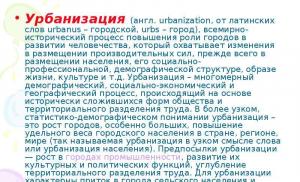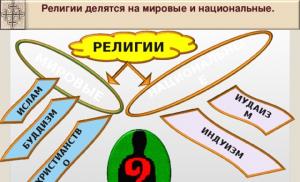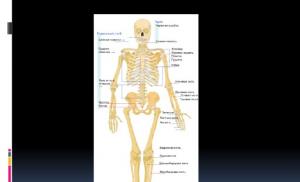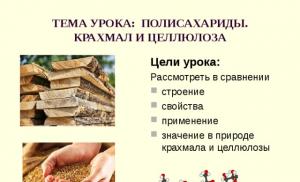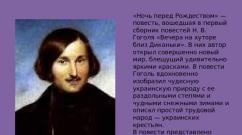Presentation on the topic of urbanization and life. The problem of urbanization Urbanization (lat.
Urban and rural population. Urbanization as a worldwide process
Lesson Plan :
1. City. Functions of the city.
2. Urbanization. Characteristic features of modern urbanization.
3. Levels and rates of urbanization.
4. Forms of rural settlements.

- "A city is a unity of dissimilarities"
Aristotle
- There are no uniform criteria for identifying cities in the world. In the USA, cities include settlements that have reached 2.5 thousand inhabitants, in the Netherlands - 20 thousand, in Iceland - 200 people. In some countries, cities include all administrative centers, regardless of the size of the population living in them. In Russia, a city is considered a settlement with at least 12 thousand people.
- In general, cities can be classified as follows:
 1 million Istra Reykjavik Novgorod Tirana Dublin Moscow FUNCTIONS OF THE CITY: scientific center, administrative center entertainment center financial transport industrial mining resort center center center center " width="640"
1 million Istra Reykjavik Novgorod Tirana Dublin Moscow FUNCTIONS OF THE CITY: scientific center, administrative center entertainment center financial transport industrial mining resort center center center center " width="640" I . City. Functions of the city.
- this is a populated area, most of the inhabitants
which is employed in industry and services.
by population:
CITY
small average big large largest millionaires
thousand . 50 - 100 thousand 100 - 250 thousand . 250 - 500 thousand . 500 - 1 million . 1 million
Istra Reykjavik Novgorod Tirana Dublin Moscow
FUNCTIONS OF THE CITY:
administrative
entertainment center
financial transport industrial mining resort
center center center center center

Ancient Indian city - Machu Picchu
Resort town - Anapa
Capital of Australia - Canberra
City of entertainment - Las Vegas

City - State - San Marino
City - port - Arkhangelsk
Adelaide - port and administrative center
Industrial center - Norilsk (the largest center of the copper-nickel industry)

The functions of a city may change due to changes in the geopolitical position, its role and importance in the country’s economy. The "functional" history of the city can be studied by becoming familiar with its original and modern coats of arms.
Coat of arms of the city of Zvenigorod
Initially, the city was built as a fortress, which was reflected in its ancient coat of arms. Now it is one of the historical centers of Russia, part of the Moscow region. As a result, the symbol of Moscow appeared in the upper left corner of the coat of arms.

TYPES OF CITY
Cities are characterized by regional differences. It is customary to highlight Western European, Arabic, African, Latin American and North American city types . They developed under the influence of various factors: historical, economic, geographical, religious, etc.

Western European city
Western European city: roots go back to the times of the Roman Empire. In the center there is a market square, a town hall, a cathedral. The narrow streets of the old city radiate away from the center.

Arab city
- Arab city: divided into new and old parts. The core of the old part is usually a fortification (citadel). It is surrounded in a tight ring by the quarters of the old city. The main decoration is the colorful bazaars.

African city
African city: developed under the influence of European colonization, the religion it brought - Christianity, and also later - Islam. European-style buildings are combined with oriental bazaars, mosques and poor neighborhoods

Latin American city
- Latin American city: created as a colonial city according to a single plan that Spain and Portugal developed for their possessions. The central part is similar to the center of a European city. On the outskirts, belts of poverty have formed, in which 30-50% of the city's population live.

North American city
- North American city: distinguished by specific features, primarily its youth. It is characterized by a clear rectangular layout with a Business Center (downtown); in other parts of the city there are low-rise individual buildings.

Diagram: “The role of cities in the modern world.”
Conclusion:


II . Urbanization - the process of growth of cities and urban population, the spread of urban lifestyle, increasing the economic role of the city.
Diagram: “Dynamics of the global urbanization process.”
Conclusion: in the 20th century there is an “urban boom” - a sharp jump in population
urban population.



Features of modern urbanization
1. Rapid growth of urban population. What do you think in what
Are urban growth rates higher in EDC or RS countries?
2. Concentration of industry and population in large cities.
3. Sprawling of cities, expansion of their territory, growth up and down.
As a result of urban sprawl, urban agglomerations .
Gor. agglomeration -
territorial grouping of urban and
rural settlements.
Currently there are about 20 agglomerations.
LARGEST URBAN AGGLOMERATIONS IN THE WORLD (million people):
1. Mexico City (28) 5. Bombay (20) 9. Seoul (16)
2. Tokyo (27) 6. Beijing (19) 10. Kolkata (15)
3. Sao Paulo (26) 7. Jakarta (18)
4. Shanghai (23) 8. New York (17)

Agglomeration- is a group of nearby cities, united by connections: labor, cultural, social, industrial
Moscow agglomeration
Mexico City. City - agglomeration
(17.9 million people)
NY. City - agglomeration
(16.6 million people)

English and Rhine megalopolises
Megalopolises of the world
Megalopolis is an urbanized zone formed by fused agglomerations.
There are six megalopolises in the world:
USA - 3 (San-San, Chipits, Boswash), Japan (Tokaido), Europe (English, Rhineland)
US megacities
 emergence of undeveloped slums. R URBANIZATION - the spread of urban forms of life in rural settlements, due to the migration of urban residents to them. UURBANIZATION is the process of growth and development of the suburban zone of large cities, while the pace of development of satellite cities is higher than the rate of development of the agglomeration core. "width="640"
emergence of undeveloped slums. R URBANIZATION - the spread of urban forms of life in rural settlements, due to the migration of urban residents to them. UURBANIZATION is the process of growth and development of the suburban zone of large cities, while the pace of development of satellite cities is higher than the rate of development of the agglomeration core. "width="640" L OZHNAYA URBANIZATION - rapid growth in numbers
ty of the urban population, not accompanied by an increase in the number
jobs = emergence of squalid slums.
R URBANIZATION - spread of urban life forms in
rural settlements, due to the migration of urban residents to them
lei
WITH UBURBANIZATION - process of growth and development of suburban
zones of large cities, while the pace of development cities -
satellites higher than the rate of development agglomer cores-
tions .
 50%), medium urbanized (from 20 to 50%) and slightly urbanized (" width="640"
50%), medium urbanized (from 20 to 50%) and slightly urbanized (" width="640" Depending on the size of the urban population (urbanization level), countries are classified as highly urbanized (50% urbanization level), moderately urbanized (from 20 to 50%), and lightly urbanized (  51% WEAKLY URBANIZED map "width="640"
51% WEAKLY URBANIZED map "width="640"
Proportion of urban population in different countries (%)
According to the level of urbanization, all countries are divided into three groups
MEDIUM URBANIZED
20 - 50%
HIGHLY URBANIZED
WEAKLY URBANIZED
map

Urbanization level
more than 50%
from 20 to 50%
less than 20%

In addition to the urban form of settlement, there are two more:
FORMS OF SETTLEMENT
RURAL
CITY
NOMADIC
Despite the rapid growth of cities, about 1/2 of the world's population still lives in rural areas, and the total number of rural settlements is 20 million.
The group form of settlement prevails in Russia, foreign Europe, China, and Japan. Farms are most common in the USA, Canada, and Australia.
In areas of nomadic cattle breeding, there are no permanent settlements at all; this is typical for Mongolia, as well as for the indigenous peoples of the north of Russia, Canada, and the USA.
GROUP
(VILLAGE)
DISTRIBUTED
(FARM, HUTOR)
Formulate a conclusion on the topic
lesson.
Topic 3 §4 (in the textbook by V.P. Maksakovsky).
Complete the assignment for the lesson.
On contact draw a map:
1. Largest cities in the world
2. Megalopolises
3. Highly urbanized, medium urbanized, low urbanized countries
(5 examples each)\


Lesson Objectives
- Find out what determined the distribution of the world's population?
- Which countries and regions are home to the largest population concentrations?
- How do cities and villages compare in size?
- How does the urbanization process occur?

The fields are ending their lives
Under the terrible chariot,
Which the spirit of the century took up arms against them,
And the tentacles stretch capital after capital,
To suck out the remaining strength from them.
E. Verharn

- The Earth is unevenly populated, with approximately 70% of the world's population living on 7% of the land area.
- More than half of all the Earth's inhabitants are concentrated in a 200-kilometer coastal strip.

Big cities are spiritual workshops where the best works of the Universe are created
Le Corbusier

- Population settlement- process
population distribution by
certain territory

Forms of settlement
rural
urban


... in the deltas of the Nile, Tigris and Euphrates, in ancient Judea, India, China. Karnak (Egypt)



Rural settlement
- Africa and Asia
- Forms: farms, villages, towns, hamlets, etc.


Now there are tens of thousands of cities on Earth!
The growth of cities, the increase in their role in society and the spread of urban lifestyle is called
urbanization ( urbs - city .latin )
Urbanization is an important indicator of the level of socio-economic development

This is interesting!
- There is no single concept of “city”:
Netherlands– population of 2 thousand people;
In Iceland, Denmark, Finland, Sweden– a populated area with a population of more than 200 people.
In Canada, Australia– over 1 thousand people
In Switzerland, Malaysia– over 10 thousand people.
In South Korea– over 40 thousand people;
In Russia a city is a populated area that has at least 12 thousand residents , at the same time, 75% of city residents should be engaged in non-agricultural activities.

Features of urbanization
- The highest level of urbanization is typical for developed countries (there are more cities than villages)


Largest cities in the world, 2010
City
Number of people, people
Shanghai
16 348 947
Mumbai
Karachi
13 830 884
13 205 339
Buenos Aires
13 080 026
New Delhi
Istanbul
12 565 901
12 175 592
Manila
11 248 470
Dhaka
Moscow
10 861 172
10 509 592
Sao Paulo
Lagos
10 381 400
Seoul
9 968 455
9 567 665
Kinshasa
8 900 721
Tokyo
8 762 073
Mexico City
8 560 994

- Large cluster of cities agglomeration.
- 1970- there are 3 agglomerations in the world:
Tokyo, New York, Mexico City
Now there are more than 20 largest agglomerations in the world (p. 61 Fig. 27)
Agglomeration – This is a compact territorial grouping of urban and rural settlements, united into a complex local system by diverse connections - labor, production, communal services, cultural and everyday life, as well as the joint use of various resources of a given area.

Largest agglomerations in the world
Moscow
New York - Philadelphia
Seoul
Tokyo
New Delhi
Osaka - Kobe - Kyoto
Shanghai
Manila
Kolkata
Mumbai
Manila
Jakarta
Sao Paulo

Largest agglomerations in the world
Agglomeration
Tokyo
Number of people, people
2010
37 730 064
Mexico City
NY
23 610 441
23 313 036
Seoul
Mumbai
22 692 652
Sao Paulo
21 900 967
Manila
20 831 058
20 654 307
Jakarta
19 231 919
New Delhi
Shanghai
18 916 890
18 572 816
18 013 728
Osaka – Kobe – Kyoto
Cairo
17 409 585
16 429 199
Kolkata
15 644 040
Moscow
14 926 656

Megalopolises of the world
Rhineland
English
Pektian
Chipits
Boswash
San San
Shanan
Tokaido
Vizagmahanagar 2
Nilsky
Xiangguan
Vizagmahanagar 1
Lagib
Jaban
San Rio
La Plata


Megalopolis – This is a group form of settlement,
formed by the accretion of closely located large urban agglomerations.
Megalopolis
Square,
thousand km2
Tokaido (Japan)
North-East "Boswash"
Population,
million people
Chicago-Pittsburgh "Chipitts" (USA)
Southern California "Sansan" (USA)
English(UK)
Rhine (Netherlands - Germany)



The fastest rates of urban population growth are observed in developing countries (the population is driven to cities by landlessness, lack of work in villages)
Features of urbanization


Features of urbanization (rate)
In developing countries, the level of urbanization is low, but the rate is high - countries of Foreign Asia, Africa, Australia and Oceania

Whole world, regions
The whole world
Rates of growth, %
Foreign Europe
Foreign Asia
Africa
North America
Latin America
Australia and Oceania


General features of the urbanization process
- Rapid urban population growth
- Concentration of population and economy in large cities
- “Sprawling” of cities, expansion of their territory

Functions of cities
- Industrial centers
- Cities - ports
- Administrative centers and capital cities
- Scientific centers
- Cities - resorts
- Tourist centers

Levels of urbanization
- According to the level of urbanization, all countries of the world are divided into:
- Highly urbanized (p. 77 fig. 18)
- Mid-urbanized
- Slightly urbanized



- Environmental pollution
- air pollution,
- high noise level,
- electromagnetic radiation,
- concentration of enterprises in a limited area,
- high population density,
- migration processes, etc., are a consequence of urbanization as a form of settlement.

Air pollution
Pollution of the water eco-system
Noise amplification

- In economically developed countries, efforts are being made to regulate the urbanization process.

As a way to solve the problem, super-tall buildings are being built and designed














Knowledge control
- 1.Name the largest megalopolises in the world. In which countries are they located?
- 2. The share of the urban population on the planet is:
A) 1-5%, b) 5-15%, c) 40-55%, d) 75-85%
3. Urbanization is...

- 4. Indicate the areas with the highest and lowest population density:
A) Australia, b) Central America,
C) Europe, central Asia, d) the Atlantic coast of South America, e) northeast of Eurasia
5. Indicate what problems arise during urban growth
Slide 1
Slide description:
Slide 2
Slide description:
Slide 3
Slide description:
Slide 4
Slide description:
Slide 5
Slide description:
Slide 6
Slide description:
Slide 7
Slide description:
2). The concentration of population and economy is mainly in large cities, because cities have many functions, especially in the non-productive sphere, they better satisfy people's needs, have a developed infrastructure and provide access to information repositories. 2). The concentration of population and economy is mainly in large cities, because cities have many functions, especially in the non-productive sphere, they better satisfy people's needs, have a developed infrastructure and provide access to information repositories. Half the world's population lives in cities. More than 30 cities in the world have a population of more than 5 million people. 3) "Sprawling" of cities, expansion of their territory. This happens when belts of satellite cities appear around large cities (capitals, industrial and port centers). Such formations are called urban agglomerations. Their uncontrolled growth greatly worries scientists working on this problem.
Description of the presentation by individual slides:
1 slide
Slide description:
Urban and rural population. Urbanization as a worldwide process. Economic and social geography of the world. Grade 10.
2 slide
Slide description:
DEAR FRIEND! Today in the lesson you will get acquainted with the forms of urban and rural settlement of the world. You will learn what urbanization is, what its features, levels, rates, and features are. Consider the environmental problems of modern cities. You will have to work with cartographic material, analyze diagrams and graphs. At the end of the lesson you will have a short test and creative homework. As you work through each slide, don't move on to the next one until you've worked through the current one. Good luck to you! Continue
3 slide
Slide description:
Based on the nature of settlement, the world's population can be divided into urban and rural. RURAL settlement arose with the development of agriculture. Currently, more than half of the world's population lives in rural areas. There are 15–20 million rural settlements. They differ in: - size; - form; - farm specialization.
4 slide
Slide description:
Modern forms of rural settlement Group (village) Most common in the countries of Central and Southern Europe, Russia, Japan and many developing countries. Scattered (farm) Most common in the USA, Canada, Australia, and Northern European countries. There are no permanent settlements in countries with nomadic pastoralism.
5 slide
Slide description:
Urban settlement Cities arose in ancient times as centers of administrative power, trade and craft. With the development of industry, industrial production was concentrated in them, infrastructure was formed, and transport connections were developed. 47% of the world's population lives in cities. Functions of modern cities: - industrial; - cultural; - scientific; - administrative; - transport. Most cities are multifunctional
6 slide
Slide description:
TASK 1. Remember, in Russia, at what population size is a settlement considered a city? What indicator, besides population, is also taken into account? This is interesting! The definition of a city varies from country to country. For example, in Sweden, Denmark, and Finland, a settlement of more than 200 people is considered a city. In Canada, Australia - over 1 thousand people, in Germany, France - over 2 thousand people, in the USA, Mexico - over 2.5 thousand people, in India, Iran - over 5 thousand people, in Switzerland, Malaysia – over 10 thousand people, in the Netherlands, Nigeria – over 20 thousand people, in Japan – 30 thousand people,
7 slide
Slide description:
Currently, the ratio of urban and rural populations is changing. TASK 2. Analyze the graph and draw a conclusion about how the dynamics of the share of the urban population changed from 1700 to 2005 with a forecast for 2015.
8 slide
Slide description:
REMEMBER! The process of growth of the urban population, an increase in the number of cities and their consolidation, the emergence of networks and systems of cities, the spread of the urban lifestyle, as well as the increasing role of cities in the modern world is called URBANIZATION (from the Latin urbs - city). Urbanization is the most important socio-economic process of our time. There are three stages in its development: Initial stage - XIX century. The process of urbanization began in Europe and North America. First half of the 20th century. Urban population growth is accelerating and urbanization is spreading to almost all regions of the world. Second half of the 20th century, beginning of the 21st century. Acceleration of the growth rate of the urban population, the development of large cities, the transition from a single city to an agglomeration, as well as the formation of megalopolises, which leads to the spread of the urban lifestyle to the countryside.
Slide 9
Slide description:
TASK 3. Analyze the diagram and determine: - which countries are the leaders in terms of the maximum and minimum share of the urban population, - what type of countries predominates in each group.
10 slide
Slide description:
FEATURES OF URBAN IZATIONS Rapid growth of urban population. Especially in less developed cities. The population concentration is mainly in large cities. Urban sprawl. Cities are turning into agglomerations, agglomerations into megalopolises.
11 slide
Slide description:
REMEMBER! Agglomerations are territorial groupings of urban and rural settlements. TASK 4. Analyze the diagram and determine: - which agglomerations were leaders in different periods; - which countries, developed or developing, lead in different years in the number of agglomerations; - write down the names of the largest agglomerations in your notebook.
12 slide
Slide description:
TASK 5. Find “The largest cities in the world” on the map. agglomerations that are among the 15 leaders. Put them on a contour map.
Slide 13
Slide description:
Megalopolis is the largest form of urban settlement, formed as a result of the merger of a large number of neighboring agglomerations. USA. The largest megalopolises: 1. North-Eastern or Bosvash includes 40 agglomerations (50 million people). The largest are Boston, New York, Philadelphia, Baltimore, Washington. 2. Priozerny or Chipits includes 35 agglomerations (35 million people). The largest are Chicago, Detroit, Cleveland, Pittsburgh. 3.California or San-San includes 18 agglomerations (25 million people). The largest are San Francisco, Sacramento, San Jose, Los Angeles, San Diego. TASK 6. Find these megalopolises on the map. Put them on a contour map.
Slide 14
Slide description:
Japan. The largest megalopolis is Tokaido. It is home to more than 70 million people, or 56% of Japan's population. Largest agglomerations: Tokyo, Yokohama, Chiba, Osaka, Kobe, Kyoto, Nagoya. TASK 7. Find this megalopolis on the map. Put it on the contour map.
15 slide
Slide description:
Rates of growth of urbanization Developed and developing countries differ sharply in the rate of urbanization. In developing countries, the urban population growth rate is 4.5 times higher than that of developed countries. They are highest in Africa and Western Asia, in countries where the level of urbanization today is the lowest. The high rate of growth in the number of city dwellers in developing countries is called the “urban explosion”. It is accompanied by an increase in the number of large cities and millionaire cities.
16 slide
Slide description:
Levels of urbanization Highly urbanized countries Moderately urbanized countries Weakly urbanized countries Proportion of urban population more than 50% Proportion of urban population 20-50% Proportion of urban population less than 20% Great Britain Venezuela Kuwait Sweden Australia Japan Algeria Bolivia Nigeria India Congo Egypt Chad Ethiopia Somalia Niger Mali Zambia
Slide 17
Slide description:
Features of urbanization Suburbanization is the movement of part of the urban population to the suburbs. This is due to the deterioration of environmental conditions in large cities and the rise in infrastructure costs. False or slum urbanization is a sharp increase in the share of the urban population in developing countries due to the influx of rural population and the formation of spontaneous settlements lacking infrastructure around large cities.
18 slide
Slide description:
Environmental problems of cities Cities account for 80% of all emissions into the atmosphere. All cities in the world annually “throw” into the environment up to 3 billion tons of solid waste, more than 500 cubic meters. m of industrial and domestic wastewater, about 1 billion tons of aerosols. Change natural landscapes.
Slide 19
Slide description:
TASK 8. Answer the questions and tasks of the test using the suggested answer forms (choose the correct line; choose the correct answer, etc.), write the answers on the test sheet and hand it in to the teacher. 1. Complete the definition: “Urbanization is...” (choose the correct line): a) form of population distribution; b) the growth of cities and the share of the urban population, the increasing importance of cities and the spread of urban lifestyles. 2. What are the basic principles laid down when dividing settlements into urban and rural? a) population size (population); b) functions of settlements, c) age of residents. 3. Find the correct answer among the proposed options: a) the share of the urban population in the world currently does not exceed 30%; b) currently 47% of the planet’s population lives in cities; c) more than 9% of the world's population is concentrated in urban settlements of the world. 4. The maximum share of the urban population is typical for the group of countries: a) Kuwait, Israel, Uruguay; b) Ethiopia, Cambodia, Nepal. 5. Finish the phrase: "False" urbanization is..." (choose the correct line): a) the movement of part of the wealthy population to the suburbs; b) the growth of cities with the formation of slum areas in them in a group of developing countries; c) urbanization in oil-producing countries countries 6. The largest agglomeration in the world (choose the correct line): a) New York, b) Tokyo, c) Sao Paulo 7. The growth rate of urban population is the highest in: a) Foreign Asia; b) Foreign Europe.
20 slide
Slide description:
HOME TASK. Page 74–80 (textbook by Maksakovsky V.P. “Economic and social geography of the world. Grade 10”). Don't forget to write down your homework in your diary. 2. Creative. Write down the questions in your notebook: - Is it possible to say that humanity has embarked on the path of transforming our Earth into a “city planet”? - Urbanization – good or bad for the planet? - Is it possible and necessary to manage the urbanization process? Express your point of view. THANK YOU FOR YOUR WORK IN THE LESSON!
The main factors that distinguish an urban settlement from a rural one are the size of its population, which is predominantly employed outside agriculture. In addition, the city has a different character of residential development compared to rural areas and a higher population density.
"A city is a unity of dissimilarities"
Aristotle
Download:
Preview:
To use presentation previews, create a Google account and log in to it: https://accounts.google.com
Slide captions:
Italy Spain Portugal Belarus England Georgia Russia Australia Germany Greece Albania Macedonia China Israel Mongolia India Nepal Japan Name the countries where the Christian religion is spread
Orthodoxy
Catholicism
Protestantism
Islam
Shintoism
The main factors that distinguish an urban settlement from a rural one are the size of its population, which is predominantly employed outside agriculture. In addition, the city has a different character of residential development compared to rural areas and a higher population density. “A city is a unity of dissimilarities” Aristotle There are no uniform criteria for identifying cities in the world. In the USA, cities include settlements that have reached 2.5 thousand inhabitants, in the Netherlands - 20 thousand, in Iceland - 200 people. In some countries, cities include all administrative centers, regardless of the size of the population living in them. In Russia, a city is considered a settlement with at least 12 thousand people. In general, cities can be classified as follows: cities Megacities (supercities formed by the merger of agglomerations) From 500 thousand to 1 million people From 100 to 500 thousand people From 1 to 10 million people agglomerations (large cities surrounded by satellite cities)
CITY 1 million in population Entertainment center Administrative and scientific centers Financial center Transport center Industrial center Mining center Resort center CITY FUNCTIONS OF THE CITY is a populated area, the majority of whose residents are employed in industry and the service sector small medium large large largest millionaires FUNCTIONS OF THE CITY OF ISTRA REYKJAVIK NOVGOROD TIRANA DUBLIN MOSCOW
Ancient Indian city - Machu Picchu Capital of Australia - Canberra Resort city - Anapa City of entertainment - Las Vegas
City - state - San Marino City - port - Arkhangelsk Industrial center - Norilsk (the largest center of the copper-nickel industry) Adelaide - port and administrative center
The functions of the city may change due to changes in the geopolitical position, its role and significance in the country’s economy. The “functional” history of the city can be studied by becoming acquainted with its original and modern coats of arms. Coat of arms of the city of Zvenigorod Initially, the city was built as a fortress, which is reflected in its ancient coat of arms. Now it is one of the historical centers of Russia, part of the Moscow region. As a result, the symbol of Moscow appeared in the upper left corner of the coat of arms.
TYPES OF CITIES Cities are characterized by regional differences. It is customary to distinguish types of cities: Western European, Arab, African, Latin American, North American. They developed under the influence of various factors: historical, economic, geographical, religious, etc.
Western European city Western European city: roots go back to the times of the Roman Empire. In the center there is a market square, a town hall, a cathedral. The narrow streets of the old city radiate away from the center.
Arab city Arab city: divided into new and old parts. The core of the old part is usually a fortification (citadel). It is surrounded in a tight ring by the quarters of the old city. The main decoration is the colorful bazaars
African city African city: developed under the influence of European colonization, the religion it introduced - Christianity, and also later - Islam. European-style buildings are combined with oriental bazaars, mosques and poor neighborhoods
Latin American city Latin American city: created as a colonial city according to a single plan that Spain and Portugal developed for their possessions. The central part is similar to the center of a European city. On the outskirts, belts of poverty have formed, in which 30-50% of the city's population live.
North American city North American city: distinguished by specific features, primarily its youth. It is characterized by a clear rectangular layout with a Business Center (downtown); in other parts of the city there are low-rise individual buildings.
2 50 80 81 Land area Population GDP Air emissions 90 80 70 60 50 40 30% 0 Conclusion: City indicators Diagram: “The role of cities in the modern world”
The problems of cities in the 21st century have become global in nature, and they are dealt with by representatives of various scientific disciplines - economists, sociologists, ecologists. Geographers are primarily interested in the spatial aspects of urbanization - patterns of the location of cities and the functioning of urban space, settlement systems, as well as environmental problems of cities.
II. Urbanization is the process of growth of cities and urban populations, the spread of the urban lifestyle, and the increasing economic role of the city. Diagram: “Dynamics of the global urbanization process.” Conclusion: in the 20th century there is an “urban boom” - a sharp jump in the urban population.
URBANIZATION CITY GROWTH GROWTH OF URBAN POPULATION FORMATION OF COMPLEX URBAN SYSTEMS
Urbanization is accompanied by an increased role of cities in the life of society, the spread of an urban lifestyle and the formation of settlement systems
FEATURES OF MODERN URBANIZATION Rapid growth rates of the urban population Concentration of industry and population in large cities “Sprawling” of cities, expansion of their territory As a result of the “sprawling” of cities, urban agglomerations appear Currently, there are about 20 agglomerations THE LARGEST URBAN AGGLOMERATIONS IN THE WORLD (million people) Mexico City (28) Tokyo (27) Sao Paulo (26) Shanghai (23) Bombay (20) Beijing (19) Jakarta (18) Seoul (16) Kolkata (15) New York (17)
Moscow agglomeration AGGLOMERATION is a group of nearby cities united by connections: cultural, social, labor, industrial New York City agglomeration (16.6 million people) Mexico City agglomeration (17.9 million people)
MEGA COLISES OF THE WORLD A megalopolis is an urbanized zone formed by fused agglomerations. There are six megalopolises in the world: Europe – 2: English, Rhine; USA – 3: San-San, Chipits, Boswash; Japan – 2: Tokaido English and Rhine megalopolises USA megalopolises
FALSE URBANIZATION - rapid growth in the urban population, not accompanied by an increase in the number of jobs => the emergence of undeveloped slums R URBANIZATION - the spread of urban forms of life in rural settlements, due to the migration of urban residents to them C UBURBANIZATION - the process of growth and development of the suburban area large cities, while the pace of development of satellite cities is higher than the rate of development of the agglomeration core
Depending on the size of the urban population (urbanization level), countries are classified as highly urbanized (urbanization level > 50%), moderately urbanized (from 20 to 50%), and lightly urbanized (
Countries with a high level of urbanization (the share of the urban population is over 50%) Moderately urbanized countries (the share of the urban population is from 20% to 50%) Slightly urbanized countries (the share of the urban population is below 20%) Depending on the size of the urban population (level of urbanization) countries vary
Countries with a high level of urbanization (share of urban population over 50%) UK – 89 ARGENTINA – 88 AUSTRALIA – 85 SWEDEN - 83 VENEZUELA – 93 BELGIUM -95 Countries with medium urbanization (share of urban population from 20% to 50%) MALAYSIA SENEGAL CONGO INDONESIA VIETNAM INDIA Slightly urbanized countries (the share of the urban population is below 20%) ETHIOPIA - 13 NEPAL - 14 MALAWI - 13 NIGER - 17 UGANDA - 12 RWANDA - 8 BURUNDI - 8 KUWAIT - 97 Depending on the number of urban population (urbanization level), countries differ
According to the level of urbanization, all countries are divided into three groups. Share of the urban population in different countries (in %) HIGHLY URBANIZED > 51% MODERATELY URBANIZED 20 - 50% LOW URBANIZED
Urbanization level more than 50% from 20 to 50% less than 20%
In addition to the urban form of settlement, there are two more: FORMS OF SETTLEMENT URBAN NOMAD RURAL GROUP (VILLAGE) DISPERSED (FARM, HUTOR) Despite the rapid growth of cities, about 1/2 of the world's population still lives in rural areas, and the total number of rural settlements is 20 million The group form of settlement prevails in Russia, foreign Europe, China, and Japan. Farms are most common in the USA, Canada, and Australia. In areas of nomadic cattle breeding, there are no permanent settlements at all; this is typical for Mongolia, as well as for the indigenous peoples of the north of Russia, Canada, and the USA.
New York Moscow Singapore Mexico City Jakarta Bombay Paris Tokyo Bonn Sao Paulo Baku Los Angeles Minsk Kolkata Seoul Rome Shanghai Vancouver Beijing Oslo Name the largest agglomerations in the world with a population of more than 14 million people
THE ANSWER IS CORRECT!
Formulate a conclusion on the topic of the lesson Topic 3 §4 (in the textbook by V.P. Maksakovsky) Complete the assignment for the lesson. Put on the contour map: The largest cities in the world Megalopolises Highly urbanized, medium-urbanized, low-urbanized countries (5 examples each) HOMEWORK
Diagram: “The role of cities in the modern world” Conclusion:
2 50 80 81 Land area Population GDP Air emissions 90 80 70 60 50 40 30% Diagram: “The role of cities in the modern world” 0 Conclusion: City indicators
